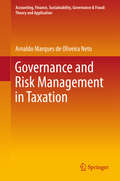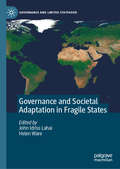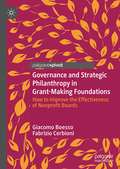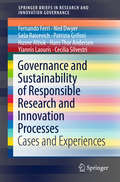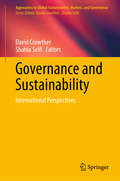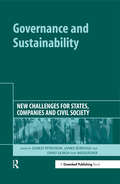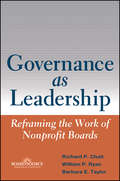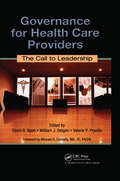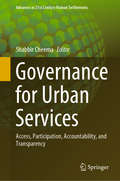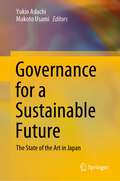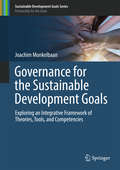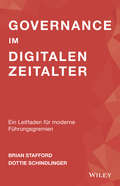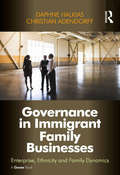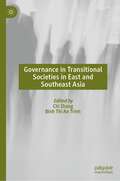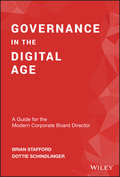- Table View
- List View
Governance and Risk Management in Taxation
by Arnaldo Marques de Oliveira NetoThis book provides insights into identifying and dealing with possible corporate tax risks. It also elaborates on how enterprises can avoid possible issuance of notices of violation, fines and default interest, and ensure reduced tax responsibility of enterprises and their administrators when dealing with tax issues, thereby bringing about increased efficiency and productivity. Conducted in collaboration with the Brazilian Enterprises Group of Advertising and Publicity Services, it also includes managerial information resources and procedures for tax risks that enterprises may encounter. Additionally, it presents findings that allow the academic community and enterprises (not only advertising and publicity services) alike to benefit from the results derived from the Model of Corporate Risk Management (GRCorp) and the Specific Model of Tax Risk Management (GRTrib) frameworks developed by the author. The book serves as a valuable resource for academic researchers and practitioners in businesses.
Governance and Societal Adaptation in Fragile States (Governance and Limited Statehood)
by Helen Ware John Idriss LahaiThis book examines the various ways in which some fragile states in the Global South (or states with limited statehood) have adopted, and adapted to, processes of governance in their quests to address the socialized problems affecting their societies. It tells the story of these states’ resilience in the societal adaptation to a liberalized notion of governance. In addition to comparative case studies, the book also analyzes the engendered interplay of culture, economics, and politics in the creation of people-centric governance reforms. The contributing authors shed light on weak states’ often constructive engagement in the promotion of state governance under a variety of societal conditions, adverse or otherwise, and on their ability to remain resilient despite the complexities of the political and economic challenges they face.
Governance and Strategic Philanthropy in Grant-Making Foundations: How to Improve the Effectiveness of Nonprofit Boards
by Giacomo Boesso Fabrizio CerbioniThis book discusses the role of grant-making foundations in supporting local communities, and how effective governance can contribute to greater success of the social projects they finance. The book considers the extent to which granting foundations act as social investment banks or strategic philanthropists, and identifies possible areas of evolution and improvement in the granting process of foundations similar to other innovative firms. It seeks to explore the possibility of foundations becoming a reference point in the Third Sector for innovativeness and risk taking.
Governance and Sustainability at Nike (A)
by Lynn S. Paine Lara Adamsons Nien-He HsiehTwo members of Nike's executive team must decide what sustainability targets to propose to Nike's CEO and to the corporate responsibility committee of Nike's board of directors. Set in 2012, the case traces the evolution of Nike's approach to environmental and social concerns from its origins in student protests against labor conditions in the supply chain in the 1990s through the development of a board-level corporate responsibility (CR) committee in 2001 to the creation of the Sustainable Business & Innovation (SB&I) strategy in 2009. In this context, Hannah Jones, Nike's VP of SB&I, and Eric Sprunk, VP of Merchandising & Product, are working to finalize the company's next round of sustainability targets for presentation to the CR committee. When Nike signs on to the Roadmap to Zero, a Greenpeace-inspired initiative to eliminate the discharge of toxic chemicals into the water supply by 2020, the company's target-setting process becomes more complex. Jones and Sprunk must decide whether to recommend that Nike dial back other sustainability goals to meet the zero toxics challenge, modify its commitment to zero toxics, or find another solution.
Governance and Sustainability at Nike (B)
by Lynn S. Paine Lara Adamsons Nien-He HsiehTwo members of Nike's executive team must decide what sustainability targets to propose to Nike's CEO and to the corporate responsibility committee of Nike's board of directors. Set in 2012, the case traces the evolution of Nike's approach to environmental and social concerns from its origins in student protests against labor conditions in the supply chain in the 1990s through the development of a board-level corporate responsibility (CR) committee in 2001 to the creation of the Sustainable Business & Innovation (SB&I) strategy in 2009. In this context, Hannah Jones, Nike's VP of SB&I, and Eric Sprunk, VP of Merchandising & Product, are working to finalize the company's next round of sustainability targets for presentation to the CR committee. When Nike signs on to the Roadmap to Zero, a Greenpeace-inspired initiative to eliminate the discharge of toxic chemicals into the water supply by 2020, the company's target-setting process becomes more complex. Jones and Sprunk must decide whether to recommend that Nike dial back other sustainability goals to meet the zero toxics challenge, modify its commitment to zero toxics, or find another solution.
Governance and Sustainability of Responsible Research and Innovation Processes: Cases and Experiences (SpringerBriefs in Research and Innovation Governance)
by Hans Thor Andersen Fernando Ferri Ned Dwyer Saša Raicevich Patrizia Grifoni Husne Altiok Yiannis Laouris Cecilia SilvestriThis book provides methods and practical cases and experiences with the aim of stimulating Responsible Research and Innovation (RRI) through the direct engagement of researchers, Civil Society Organisations (CSOs), citizens, industry stakeholders, policy and decision makers, research funders and communicators. The book furthermore aims to advance debate on Responsible Research and Innovation and also to reinforce the RRI community identity. With chapters covering governance, public engagement and inclusion in responsible R&D and innovation processes; RRI actions in science education and communication; gender and ethical issues in RRI initiatives; and sustainability of RRI processes, the book is solidly part of the Europe 2020 strategy to promote a vision for a stronger collaborations between social, natural and physical scientists and the societal actors for a wider dimensions of science and innovation and the role in environmental preservation.
Governance and Sustainability: International Perspectives (Approaches to Global Sustainability, Markets, and Governance #8)
by David Crowther Shahla SeifiThis book explores the concepts of sustainability and governance in relation to the governance of corporations – hence the ubiquity of the term corporate governance – and other bodies. It examines how these concepts are regularly used by politicians and by the media. The two concepts are however largely treated as being separate and discrete, and given equal coverage. The argument in this book is that the two concepts are inter-related and that good governance is a prerequisite for sustainability. The focus of the book therefore is different from most, as it seeks to integrate these two important issues.The approach used in this book is based on the tradition of the Social Responsibility Research Network – a worldwide body of scholars that, over its 20-year history, has sought to broaden the discourse and to treat all research as inter-related and business-relevant.The book examines diverse aspects of the changes to corporate and institutional behaviour that have recently manifested by focusing on these two aspects of sustainable development. Thus, the authors explore engagement and partnership between organisations, in order to consider the extent to which the focus has changed so much that we need to think about new approaches to our understanding of sustainability and differing effects in practice. The international mix of authors makes this an original contribution, sharing some of the best ideas from around the world.
Governance and Sustainability: New Challenges for States, Companies and Civil Society
by Ulrich Petschow Ernst Ulrich von Weizsäcker James RosenauSustainability cannot be achieved without good governance. The Johannesburg World Summit on Sustainable Development in 2002 stated that governance and sustainable development are intimately tied together and the future role and architecture of institutions, from local to international levels, will be crucial determinants to whether future policies and programmes for sustainable development will succeed. But these are changing times. With growing tensions over both globalization and regionalization, traditional systems of regulation are being subjected to growing pressure for reform. While states will continue to play a significant, if changed, role in the future, the importance of players from business and civil society is increasing. Sustainable development requires this change. Such an intra- and intergenerational concept cannot be achieved with a top-down approach, but rather needs the participation of all. In fact, the governance of sustainable development requires the exploration of new forms of both social co-operation and confrontation. By doing so, the different levels (global and local), players (state, company and civil society), control structures (hierarchy, market and public-private) and fields of action need to be taken into consideration.Governance and Sustainability examines the possibilities of integrating the environmental, social and economic dimensions of sustainable development within the framework of governance processes and how that might steer societies towards sustainability. It takes a close look at the key actors, their agendas and methods, forms of organization, problems and limits, as well as real-life examples for governance in different areas of society at the regional, national and international level. It is especially interested in exploring the nature of changes in the context of governance; the role of actors in such processes; and analysing how different forms of societal learning can improve governance processes. It concludes that this is a continuous process, characterized by conflicts and learning processes necessary to heighten both awareness of the complexity of the social and environmental problems faced and the prospects of implementing successful solutions. Based on a major conference hosted to assess the issue of governance post-Johannesburg, the book includes innovative insights from some of the leading thinkers in both sustainable development and governance from academia, business, multilateral organizations and NGOs. It provides a unique perspective on two of the key societal problems facing the world today.
Governance and the Market for Corporate Control (Routledge Contemporary Corporate Governance)
by John L. TeallGovernance and the Market for Corporate Control is a textbook for use on business courses dealing with mergers, acquisitions, governance restructuring and corporate control. Three key features distinguish this book from competing texts. First, following up on recent developments in the corporate arena, it places a heavy emphasis on managerial compensation, incentives and corporate performance. Second, its conciseness allows for flexibility of use. Third, its coverage is broad and examines many topics including: significant discussions of corporate governance power and voting managerial compensation takeovers going private transactions corporate restructuring event study methodology. As well as combining theoretical, empirical, quantitative and practitioner-oriented matter, the material in this key book provides the academic foundation necessary to ensure students’ understanding of important concepts.
Governance as Leadership
by Ryan Taylor Barbara E. Chait Richard P. William P.A new framework for helping nonprofit organizations maximize the effectiveness of their boards. Written by noted consultants and researchers attuned to the needs of practitioners, Governance as Leadership redefines nonprofit governance. It provides a powerful framework for a new covenant between trustees and executives: more macrogovernance in exchange for less micromanagement. Informed by theories that have transformed the practice of organizational leadership, this book sheds new light on the traditional fiduciary and strategic work of the board and introduces a critical third dimension of effective trusteeship: generative governance. It serves boards as both a resource of fresh approaches to familiar territory and a lucid guide to important new territory, and provides a road map that leads nonprofit trustees and executives to governance as leadership. Governance as Leadership was developed in collaboration with BoardSource, the premier resource for practical information, tools and best practices, training, and leadership development for board members of nonprofit organizations. Through its highly acclaimed programs and services, BoardSource enables organizations to fulfill their missions by helping build effective nonprofit boards and offering credible support in solving tough problems. For the latest in nonprofit governance, visit www. boardsource. org, or call us at 1-800-883-6262.
Governance for Health Care Providers: The Call to Leadership
by David B. Nash William J. Oetgen Valerie P. Pracilio Michael D. ConnellyMedical professionals who serve on the boards of private, nonprofit institutions often do so with much more diligence than knowledge. Very little material exists to cover the range of issues that are so vital at a time when health care institutions face patient overloads, budget shortages, and calls for reform. Written by leading health care adv
Governance for Nonprofits: A Board of Directors Guide to a Profitable Not-for-Profit Corporation
by Ted E. DeGrootNonprofit governance is like sports officiating. Umpires and referees don’t play the game. They manage the game. That's what governance does for a nonprofit organization. People assigned to governance oversee how the organization is managed and work to ma
Governance for Pro-Poor Urban Development: Lessons from Ghana (Routledge Explorations in Development Studies)
by Franklin Obeng-OdoomThe world development institutions commonly present 'urban governance' as an antidote to the so-called 'urbanisation of poverty' and 'parasitic urbanism' in Africa. Governance for Pro-Poor Urban Development is a comprehensive and systematic analysis of the meaning, nature, and effects of 'urban governance' in theory and in practice, with a focus on Ghana, a country widely regarded as an island of good governance in the sub region. The book illustrates how diverse groups experience urban governance differently and contextualizes how this experience has worsened social differentiation in cities. This book will be of great interest to students, teachers, and researchers in development studies, and highly relevant to anyone with an interest in urban studies, geography, political economy, sociology, and African studies.
Governance for Urban Services: Access, Participation, Accountability, and Transparency (Advances in 21st Century Human Settlements)
by Shabbir CheemaThis book examines three vital issues in urbanization and democratization: the institutional structures and processes of urban local governance to improve access to urban services; their outcomes in relation to low-income groups’ access to services, citizen participation in local governance, accountability of local leaders and officials, and transparency in local governance; and the factors that influence access to urban services, especially for the poor and marginalized groups. Further, it describes decentralization policies, views of the residents of slums on the effectiveness of government programs, and innovations in inclusive local governance and access to urban services.
Governance for a Sustainable Future: The State of the Art in Japan
by Yukio Adachi Makoto UsamiAlthough the expression “responsibility to future generations” is firmly established in public and political vocabulary, its operational meaning and practice are inadequately understood and yet to be systematically evaluated. Moreover, the term has not been successfully translated into viable ethical and theoretical concepts that can guide public policies and actions. How can the modes of governance and established policy priorities become compatible with the well-being of future generations? The primary objective of this book is to identify the conditions of and obstacles to governance for a sustainable future, or future-regarding governance. Governance concerns steering a society over extended periods of time, not responding to particular policy issues. The ideas and strategies proposed by contributors in this book to establish future-regarding governance are based on the theoretical and empirical analyses of the major long-term problems facing advanced democracies in general, and Japan in particular. Japan is an interesting case indeed. Relatively poor climate policy, rapidly decreasing birth rate, aging population, extensive public debt, prolonged economic recession, healthcare and pension systems that urgently require redesigning, hollowing-out of industries and subsequent loss of jobs, deteriorating infrastructures, increasing nuclear waste, and intensifying social polarization have caused a decline in people’s trust in the government and democratic processes. Currently, Japanese citizens are widely circulating their doubts about the social system’s sustainability. This book comprises two parts. In Part I, authors from various disciplinary backgrounds examine the idea of governance for a sustainable future from theoretical perspectives. This part discusses issues associated with future-regarding governance that are wicked in nature, such as the philosophical/ethical foundation on which to base the idea of governance for a sustainable future, major impediments to the development of future-regarding governance, and the modes of thinking and action required by leaders and citizens to realize such governance. Chapters in Part II largely focus on the state of long-term governance in Japan. This part uses empirical and in-depth analyses with cross-sectoral and cross-national policy perspectives to identify the state of future-regarding governance in various policy fields and major sectors or organizations mainly in Japan, while also examining strategies and measures to improve their performance. From this perspective, Western democracies and weak democratic regimes elsewhere will be provided with valuable lessons to avoid fatal policy mistakes, thereby improving future-oriented governance worldwide. By combining theoretical discussions on far-reaching issues and empirical analyses of Japanese cases, the book will shed a new light on governance for a sustainable future.
Governance for the Environment
by Magali A. Delmas Oran R. YoungWe live in an era of human-dominated ecosystems in which the demand for environmental governance is rising rapidly. At the same time, confidence in the capacity of governments to meet this demand is waning. How can we address the resultant governance deficit and achieve sustainable development? This book brings together perspectives from economics, management, and political science in order to identify innovative approaches to governance and bring them to bear on environmental issues. The authors' analysis of important cases demonstrates how governance systems need to fit their specific setting and how effective policies can be developed without relying exclusively on government. They argue that the future of environmental policies lies in coordinated systems that simultaneously engage actors located in the public sector, the private sector, and civil society. Governance for the Environment draws attention to cutting-edge questions for practitioners and analysts interested in environmental governance.
Governance for the Sustainable Development Goals: Exploring An Integrative Framework Of Theories, Tools, And Competencies (Sustainable Development Goals Series)
by Joachim MonkelbaanThis book provides a detailed overview of governance for the Sustainable Development Goals (SDGs). Adopting a unique integrative approach, it examines the fragmentation of governance that is a critical barrier to achieving the SDGs. The main question addressed is: What are the crucial elements and the organizing logic of an integrative framework that is suitable for analysing governance for the SDGs and for implementing the transitions that we need towards a more sustainable world?This transdisciplinary book first proposes a combination of innovative governance theories that can improve the analysis and practice of sustainability governance. Secondly, it explores the interests of core actors in a number of case examples. And thirdly, it offers recommendations for improving the study and practice of sustainability governance.The findings presented form the basis for a new approach to governance towards objectives such as the SDGs: Integrative Sustainability Governance (ISG). The ensuing ISG framework includes indicator frames within the pillars of power, knowledge and norms. The book concludes that the transformation of crisis into sustainability transitions requires a deeper consideration of risk management that strengthens resilience; systems deliberation that complements democracy; and behavioral insights that elevate human awareness and collaboration. This handbook is a comprehensive and valuable companion for students, experts and practitioners with an interest in the SDGs.
Governance im digitalen Zeitalter: Ein Leitfaden für moderne Führungsgremien
by Brian Stafford Dottie SchindlingerDas Buch von Brian Stafford und Dottie Schindlinger stellt die technologiegetriebenen Veränderungen im Bereich der Corporate Governance (Unternehmensführung) dar und beschreibt die Auswirkungen dieser Veränderungen auf die Organe und die Unternehmen, die sie leiten. Es beschreibt auch, wie die Zukunft aussehen könnte, wenn Unternehmen die Macht der Technologie zur Veränderung der Unternehmensführung wirklich nutzen. Darüber hinaus zeigt das Buch anhand einer Reihe von Aktionsschritten, wie Unternehmen und ihre Vorstände die Technologiewerkzeuge nutzen können, um die Governance sofort zu verbessern. Durch einen Überblick über die neuesten Forschungen, Interviews mit wichtigen Meinungsführern und Fallstudien von Unternehmen, die sich der Governance-Technologie verschrieben haben, werden die Leser mit neuen Erkenntnissen und Ansätzen versorgt, die sie anwenden können, um die Arbeit ihrer Vorstände und Führungskräfte zu verbessern und neue Leistungsniveaus zu erreichen. Das Buch: - erklärt, wie Design- und Bewertungstechniken zur Entwicklung erfolgreicher interaktiver Technologien eingesetzt werden können. - demonstriert anhand vieler Beispiele die kognitiven, sozialen und affektiven Probleme, die dem Design dieser Technologien zugrunde liegen. - bietet Denkanstöße für Design-Dilemmata und Interviews mit erfahrenen Designern und Forschern. - verwendet ein starkes pädagogisches Format, um Verständnis und Freude zu fördern.
Governance in Higher Education: Global Reform and Trends in the MENA Region
by Nehme Azoury Georges YahchouchiOver the years, the education sector has witnessed substantial transformations and developments, driven primarily by the rapid growth of technology and inventive pedagogical approaches. In the MENA region, these changes have been particularly noteworthy, as educational institutions are striving to keep pace with global advancements while addressing unique regional challenges. Set against this context, this book delves into two pivotal dimensions that have surfaced as vital for thriving in today's educational sphere, with a strong emphasis on the MENA region's distinct characteristics and opportunities. The first dimension explores the evolution and challenges in governance, encompassing the organizational frameworks, decision-making mechanisms, and policies that empower educational institutions in the MENA region to adapt to the shifting environment. The second dimension zeroes in on the metamorphosis of education itself, emphasizing the innovative tools, assignments, and methodologies that are accessible to educators in the region, and discussing the balance between these elements and effective university governance. By offering an exhaustive and up-to-date examination of these two dimensions, this book imparts invaluable insights and pragmatic guidance to educational professionals, policymakers, and students alike, all with a focus on the MENA region. It aims to equip readers with the knowledge and abilities required to successfully navigate the new educational landscape and excel in the world of academia while highlighting the unique potential and prospects of the region's educational institutions.
Governance in Immigrant Family Businesses: Enterprise, Ethnicity and Family Dynamics
by Daphne Halkias Christian AdendorffFamily businesses constitute some of the most unique, complex, and dynamic systems in modern society. The blending of the performance-based world of business and the emotion-based domain of the family creates a system potentially fraught with confusion and conflict. The significant rise in immigrant family businesses adds a further level of complexity to this mix. Research into immigrant family businesses has been based on traditional, limited views of entrepreneurship largely ignoring the ethnic and family contexts that create the culture from which entrepreneurship emerges, making it impossible to understand the complex and interdependent relationships between an owning family, its firm, its governance and the community context in which the firm operates. These firms possess features that make their governance a challenging task. They depict a complex stakeholder structure, whereby the ownership stakes are passed from one generation to the next. The owning family's members usually play multiple roles, thereby blurring governance relationships. Governance in Immigrant Family Businesses explores the relationship between ethnic cultural influence in family businesses and its impact on corporate governance, addressing the intertwined influences of contractual, relational and cultural governance mechanisms and sets out a comprehensive theoretical model which clarifies the complexities involved in business planning, family harmony, and ethnic cultural variables. The authors specifically identify the implications for research, education, and practice. Application of their model will be of value to policy makers, consultants, business researchers and educators.
Governance in Northern Ontario
by Charles Conteh Bob SegsworthThis book analyzes economic development policy governance in northern Ontario over the past thirty years, with the goal of making practical policy recommendations for present and future government engagement with the region. It brings together scholars from several disciplines to address the policy and management challenges in various sectors of northern Ontario's economy, including the mining, pulp and paper, and tourism industries, and both small- and medium-sized businesses.Governance in Northern Ontario assesses the role of the provincial government and its economic policy intervention in the region's economic development. The contributors evaluate the relationship between the provincial and local governments and the business sector, and also looser structures of policy networks, such as those of First Nations and other interested community groups. Focusing on the nature of partnerships between governments and societal interests, Governance in Northern Ontario makes a significant contribution to the theories and practice of public policy governance in socioeconomically disadvantaged regions.
Governance in Post-Conflict Societies: Rebuilding Fragile States (Contemporary Security Studies)
by Derick W. BrinkerhoffForeword Frederick D. Barton Preface Derick W. Brinkerhoff 1. Governance Challenges in Fragile States: Re-Establishing Security, Rebuilding Effectiveness, and Reconstituting Legitimacy Derick W. Brinkerhoff Part 1. Governance and Post-conflict: Perspectives on Core Issues 2. Does Nation Building Work? Reviewing the Record Arthur A. Goldsmith 3. Constitutional Design, Identity and Legitimacy in Post-Conflict Reconstruction Aliza Belman Inbal and Hanna Lerner 4. Election Systems and Political Parties in Post-Conflict and Fragile States Eric Bjornland, Glenn Cowan, and William Gallery 5. Democratic Governance and the Security Sector in Conflict-affected Countries Nicole Ball Part 2. Actors in Governance Reconstruction: Old, New, and Evolving Roles 6. From Bullets to Ballots: The U.S. Army Role in Stability and Reconstruction Operations Tammy S. Schultz and Susan Merrill 7. The Private Sector and Governance in Post-Conflict Societies Virginia Haufler 8. Rebuilding and Reforming Civil Services in Post-Conflict Societies Harry Blair 9. Contributions of Digital Diasporas to Governance Reconstruction in Fragile States: Potential and Promise Jennifer M. Brinkerhoff Part 3. Reforming and Rebuilding Governance: Focus on the Local 10. Decentralization, Local Governance, and Conflict Mitigation in Latin America Gary Bland 11. Subnationalism and Post-conflict Governance: Lessons from Africa Joshua B. Forrest 12. Subnational Administration and State Building: Lessons from Afghanistan Sarah Lister and Andrew Wilder About the Contributors Index
Governance in Transitional Societies in East and Southeast Asia
by Chi Zhang Binh Thi An TrinhThis book brings together scholars based in, or had previously been based in a range of East and Southeast Asian countries, building on their respective primary empirical data and first-hand experience as academics and think tank researchers, in order to pluralise the current debates about governance in transitional societies. In an era of global democratic backsliding, this edited volume offers less-explored local perspectives, to balance the Western-centrism observed in area studies and the focus on former Soviet countries in transit. What is the future of governance in Asia? This book, by attempting to supply a diversity of answers, will interest political scientists, economists, and journalists.
Governance in der Sozialwirtschaft: Eine Einführung (Basiswissen Sozialwirtschaft und Sozialmanagement)
by Ludger KolhoffIn diesem Lehrbuch werden Governance-Aspekte auf verschiedenen Ebenen verständlich dargestellt und erläutert: Nach einem Blick auf die wirtschafts- und politikwissenschaftlichen Wurzeln der Governance-Diskussion werden auf der Makroebene „Orders of Governance“ politische und ökonomische Aushandlungs- und Problemlösungsprozesse erörtert und institutionelle und normative Rahmenbedingungen betrachtet; auf der Mesoebene „Cooperation“ geht es um Formen der Steuerung und der Kontrolle sowie um die Kooperation und Koordination von sozialwirtschaftlichen Unternehmen; und auf der Mikroebene „Interactions“ wird Governance aus der Perspektive der Akteure und ihrer Interaktionen behandelt.
Governance in the Digital Age: A Guide for the Modern Corporate Board Director
by Brian Stafford Dottie SchindlingerA new edition of the #1 text in the human computer Interaction field! This book seeks to chart the technology-fueled changes taking place in the field of corporate governance and describes the impact these changes are having on boards and the enterprises they govern. It also describes what the future could look like once companies truly embrace the power of technology to change governance. Additionally, this book will provide a set of "suggested action steps" for companies and their boards focused on ways they can leverage technology tools to enhance governance immediately. Through a review of the latest governance research, interviews with key thought leaders, and case studies of enterprises that have embraced governance technology, readers will be armed with new insights and approaches they can take to enhance the work of their boards and senior leaders to reach new levels of performance. Explains how to use design and evaluation techniques for developing successful interactive technologies Demonstrates, through many examples, the cognitive, social and affective issues that underpin the design of these technologies Provides thought-provoking design dilemmas and interviews with expert designers and researchers Uses a strong pedagogical format to foster understanding and enjoyment An accompanying website contains extensive additional teaching and learning material including slides for each chapter, comments on chapter activities, and a number of in-depth case studies written by researchers and designers.
